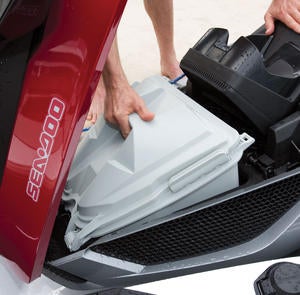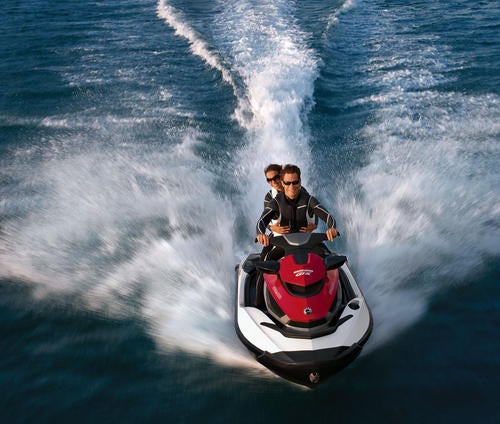2011 Sea-Doo GTX iS 215 Review
Suspension...at a more affordable price
Perhaps Sea-Doo was right to initially introduce suspension on its priciest, top-of-the-line models, but last year the Canadian manufacturer tried to bring the price of that technology down. How? By keeping the same suspension package, but offering a slightly less powerful, more mainstream engine within.
The result is the GTX iS…215.
Practical Power
As the name makes clear, GTX iS 215 uses the 215hp variant of Sea-Doo’s well-known 4-TEC engine, a 1,494cc four-stroke that, in one guise or another, powers the manufacturer’s entire line. It’s only a small knock down on the evolutionary scale — the 215 still features the supercharger/intercooler combo that gives this engine its punch. Expect a top speed of 64 – 65 mph, and enough low-end grunt to satisfy your desire to punch it out of the hole or pop your friends out of the water skiing or wakeboarding.
That low-end punch can be exploited, or tamed, depending upon how you set the craft’s two modes, Sport or Touring. Touring, by default, tempers the engine’s power, maintaining the same top speed but making sure the craft gets there in a little less brutal fashion. Sport gives you access to the engine’s full potential. Choosing between the two is accomplished with the push of a button (though Touring is the standard setting at startup).
That same electronic throttle technology also makes possible cruise control. Find your desired speed, push a button, and you can simply squeeze the throttle fully and grip the bars. Considerable tension is relieved from your throttle finger, which should make for far more comfortable long-distance cruising. Release the throttle to disengage. A no-wake mode operates in similar fashion, holding speeds from about 1-7 mph, and not requiring pressure on the throttle.
Big Softy

Now back to that suspension.
In case you’ve been out of the loop in recent years, here’s how Sea-Doo pulls it off. Essentially, the hull and the rider area — seat, handlebars, and footwells — are two separate units. The top half is attached to the bottom half below by a twin-arm suspension, and cushioned by a combination of shock absorber and centrally mounted spring, which produces about six inches of vertical travel between the two components. The craft’s computer determines the amount of pre-load to apply to the spring when the craft is started by taking into account the weight on the seat. A manual setting can be activated to override the auto setting to produce a softer, or stiffer, ride on a scale of 1-9.
It works for the most part. The suspension doesn’t take out all the jolts of rough water, but it does considerably soften the pounding. That makes it easier to ride longer, as well as more comfortable. Passengers likely benefit the most, as they don’t take nearly the jolts they would on a stock craft in rough conditions.
 Here is the GTX iS 215 with the suspension fully compressed.
Here is the GTX iS 215 with the suspension fully compressed.That hull below is the same stepped design Sea-Doo introduced on the GTX Limited iS 260 and RXT iS 260. Even without the suspension, it handles rough water far better than its predecessors, and gives the GTX models a big-water pedigree they were previously lacking. Yet, it still carves a hard turn like the GTX models of old. Really crank things hard and you can actually feel the suspension compress, while the hull maintains its bite. The downside? The driver’s center of gravity is now slightly higher. At slow speeds, the boat may feel slightly tippy during abrupt changes in direction.
Give Me More
 The comfortable touring saddle is hinged and rises on a gas strut for easy maintenance access.
The comfortable touring saddle is hinged and rises on a gas strut for easy maintenance access.The iS 215 provides all that consumers have come to expect from Sea-Doo, including a comfy, bolstered touring saddle. It’s hinged and rises on a gas strut for maintenance access. Other touches I appreciate include an info display that tilts with the handlebars, so that the driver has a clear view no matter what the position; Sea-Doo’s learning key lanyard, which serves as both a security device and a speed limiter; and a very welcome trigger throttle that has replaced decades of Sea-Doo thumb throttles.
Probably the biggest extra, however, is Intelligent Brake and Reverse (iBR). Again, the synopsis for those who haven’t been paying attention the last few years: iBR uses a modified reverse bucket to redirect water flow from the pump. Squeeze the port handgrip lever and the bucket is lowered into the flow, redirecting water to the sides and forward to provide stopping power. The force of the stop is determined by the amount the brake lever is squeezed. iBR shortens stopping distance by almost 50%. At idle speeds, that same lever puts the craft into reverse, allowing a driver to always keep his or her attention on the water and hands on the handlebars.
I still, however, think the coolest thing about iBR is the control it offers around the dock, marina, or launch ramp. iBR-equipped models start mimicking a neutral mode, meaning they don’t surge forward as water begins to exit the pump. Moving between forward and reverse is then an intuitive movement that gives even the most novice captain a healthy dose of confidence.
Final Word
 Cargo space on the GTX iS 215 is at a premium.
Cargo space on the GTX iS 215 is at a premium.Is anything sacrificed to create a machine with suspension? Yes, to be honest, although it’s likely not a deal breaker — storage. Forget the massive front tub you might have come to expect. A suspension model like the iS 215 provides a relatively paltry 16 gallons of storage space. That’s tiny compared to the competition from both Kawasaki and Yamaha. But on an iS, capacity takes a back seat to comfort, and its buyers likely accept it.
As to whether or not you can accept a still hefty $14,899 price tag, that’s a question only your budget will answer. By using the 215 engine, Sea-Doo has shaved $1,600 from the iS Limited, and $400 from the RXT iS 260. In the process the company has also provided a tamer feeling ride for those who may think the top-model craft have become too intimidating.
Either way, test ride an iS model before you pass judgment.
| Sea-Doo GTX 155 Specs | |
| Length | 139 inches |
| Beam | 48 inches |
| Curb Weight | 960 lbs |
| Engine | Three-cylinder EFI, Supercharged/Intercooled |
| Displacement | 1,494 cc |
| Bore and Stroke | 100 mm x 63.4 mm |
| Compression Ratio | 8.4:1 |
| Rated Horsepower | 215 |
| Fuel Capacity | 18.6 gal. |
| Combined Stowage Capacity | 16.4 gal. |
| Colors | Autumn Red |
| Price | $14,899 |
Related Reading
2011 Sea-Doo GTX Limited iS 260 Review
2011 Sea-Doo GTX 155 Review
2011 Sea-Doo RXT-X 260 Review
Get PersonalWatercraft.com in your Inbox!
Like PersonalWatercraft.com on Facebook
Comments
Most Popular

2025 Yamaha JetBlaster PRO 2-Up Review

2024 Kawasaki Jet Ski STX 160X Review

Remembering the Sea-Doo XP

Whatever Happened to the Wetbike?

2025 Yamaha JetBlaster Review















 Your Privacy Choices
Your Privacy Choices